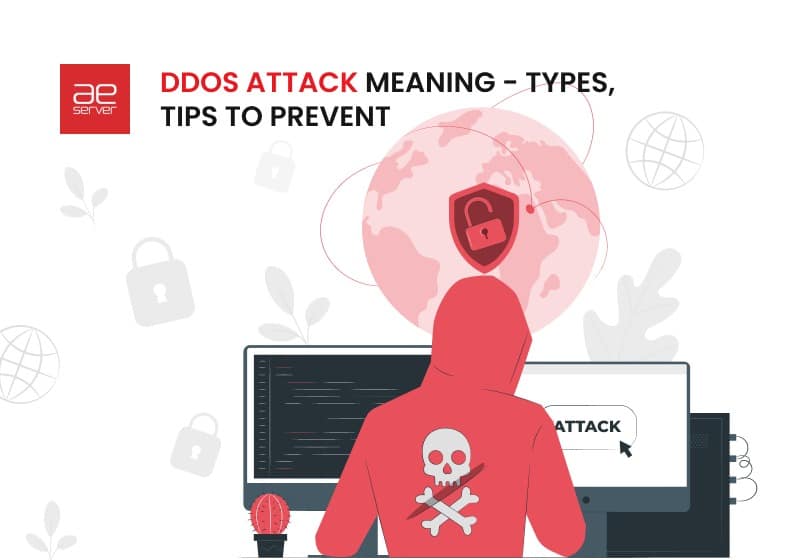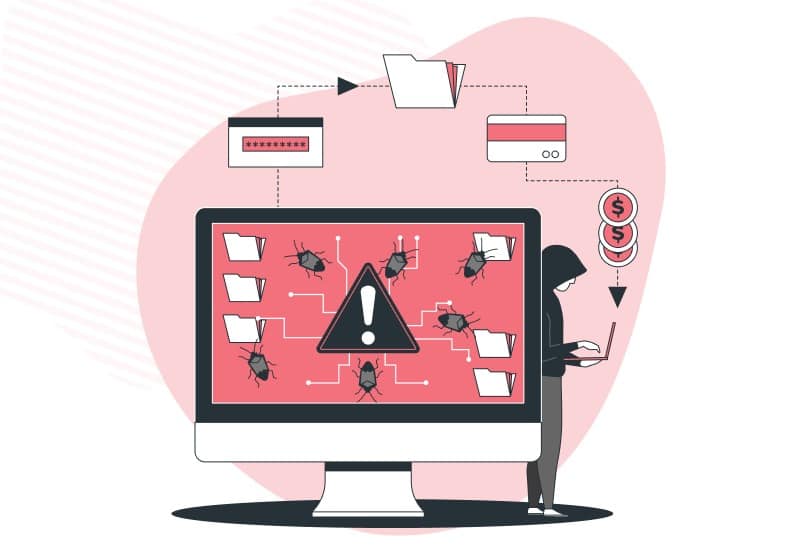
DDoS Attack Meaning – Types, Tips to Prevent
The online world is constantly changing. This means people and businesses always have to be alert. Some might hear ‘DDoS attack’ and think it’s just a techno-jargon. But the impact of a DDoS attack online spreads wide in the digital world. In simple terms, the DDoS attack meaning is about hackers overloading online services with too much traffic. This makes them unusable. The fallout can be devastating for businesses that rely heavily on online operations. Downtime, loss of revenue, and reputational damage are just the tip of the iceberg. Our dependency on digital platforms surges. So, knowing about different DDoS attacks and how to prevent them is essential. Let’s unravel the intricacies of these attacks and equip ourselves with tips to fortify their online presence.
What is a DDoS Attack?
DDoS means an intentional attempt to disrupt the natural flow of online services. Imagine a busy restaurant. Suddenly, countless fake customers flood it, leaving no room for genuine patrons. That’s an online DDoS attack but in the digital realm. Malicious entities are behind these DDoS attacks. They jam websites or online services with overwhelming traffic. It’s not just a random act of online mischief. These attacks often have motives, from seeking ransoms to competitive rivalry or even just to prove a point. Given our heavy reliance on online platforms, understanding DDoS is pivotal. But how is such a large-scale disruption even executed on the Internet?
How Do DDoS Attacks Work?
The meaning of a DDoS attack is simple. It’s a way to make a website or service get too many requests at once. This can cause it to slow down or crash entirely. But how does one system generate such massive traffic? The answer lies in the ‘Distributed’ part of the term. Cyber attackers harness a network of devices, often called a ‘botnet.’ They command them to send simultaneous requests to a single target. When discussing a DDoS attack, picture hundreds or even thousands of devices acting in unison to overload a website. This messes up the site and causes problems for businesses and their customers.
Types of DDoS Attacks
When diving into the DDoS attack online landscape, it quickly becomes evident that not all attacks are created equal. They vary in methods, targets, and intensity. Cybercriminals employ various tactics to cause chaos online. Familiarizing oneself with these strategies is the first step in understanding how they might affect us. Some attacks resemble a loud disturbance in a quiet room, drawing immediate attention. But others operate subtly, sneaking in almost unnoticed. But no matter their approach, the outcome remains consistent: disruption and chaos. Recognizing these types is crucial with a growing number of businesses and services relying on the Internet. So, let’s delve into the most common types of DDoS attacks plaguing the digital world.
Volume-Based Attacks
Imagine a floodgate suddenly opening, unleashing a torrent of water. That’s the essence of volume-based attacks. When dissecting the DDoS attack meaning within this context, it’s about creating a digital flood. Hackers utilize multiple devices to generate an immense traffic volume, sending it all at once towards a specific website. This relentless surge aims to use up all available bandwidth, causing the targeted site to slow down or crash. Such a DDoS attack is not about targeting vulnerabilities in software or hardware. It is simply about overwhelming the system with sheer volume. It’s a brute force approach, intending to drown out legitimate user traffic, causing disruption and chaos.
Application Layer Attacks
Unlike their volume-based counterparts, these attacks are like stealthy infiltrators. They target specific aspects of a website or application. By understanding the DDoS attack meaning in this light, we can visualize a hacker pinpointing particular parts of an app, exploiting its weaknesses, and disrupting its usual functions. They might focus on a login page, a checkout process, or any component that, when halted, can bring the entire operation to a standstill. These attacks demand a keen understanding of the application’s structure. They are often more challenging to detect and mitigate, so they are especially dangerous.
Protocol Attacks
Protocol attacks exploit vulnerabilities in server protocols. These are essential rules and conventions that allow systems to communicate. To grasp the DDoS attack meaning here, envision it as breaking the greeting between two devices. These attacks zero in on particular areas, like connection tables. They consume server resources and make the system unresponsive. In essence, it’s like jamming the gears of a machine. Protocol attacks cause the entire mechanism to stall, preventing genuine users from accessing online services.

Recognizing the Signs of a DDoS Attack
Being able to spot a DDoS attack online swiftly is pivotal for mitigation. The quicker you catch it, the faster you can respond. Here’s a convenient list to help you identify potential signs:
- Sudden traffic surge: A drastic and unexpected increase in user traffic can be a clear indicator, especially if it’s not during a known event or sale.
- Service slowdown: Your website or service might become uncharacteristically slow or unresponsive. It’s a sign to check things out if it’s out of the ordinary.
- Complete outage: In more severe cases, your online service might become entirely inaccessible to users.
- User reports: Always listen to your users. If they report difficulty accessing your service, it might indicate a DDoS attack.
- Spam surge: An unusual increase in spam emails or messages can sometimes accompany these attacks.
Regular monitoring, combined with this checklist, can empower you to detect a DDoS attack and take swift action.
The Impact of DDoS Attacks
The fallout from a DDoS attack stretches far beyond mere technical disruptions. On the surface, one might see a website going offline, but the underlying repercussions run deep. Downtime can translate to financial losses for businesses that rely on online transactions. And it’s not just about immediate revenue. The perception of weak security can damage the brand’s reputation. This can make customers lose trust and loyalty. Furthermore, if these attacks break into data, they might reveal private details. This could cause legal problems down the road. For users, the inconvenience of not accessing essential services can be frustrating. The emotional impact and potential data theft only magnify the overall effect. Simply put, a DDoS attack affects business, technology, and even personal spheres. So proactive measures are essential.
Tips to Prevent DDoS Attacks
It is important to know about the different types of DDoS attacks. But the next logical step is learning how to stop them so the online experience isn’t disturbed. It’s similar to fortifying a castle before an impending siege. Proactive measures can make our online spaces stronger. Moreover, they can make attackers think twice before trying anything. There are many ways to prevent DDoS attacks. Some ways include updating software often and improving whole systems. Some tactics involve technical prowess, while others just require basic vigilance. Before we dive deep into these strategies, it’s essential to remember that the digital realm is ever-evolving. What works today might need to be adapted tomorrow. Armed with this mindset, let’s explore the key preventative measures.
Implementing Robust DDoS Protection
It might seem like a no-brainer, but having DDoS protection is the first step. Services like AEserver offer robust DDoS protection mechanisms to ensure data protection and continued online service. DDoS protection acts as a barrier, filtering malicious traffic before reaching your website or service. Continuously monitoring incoming traffic discerns between genuine users and potential threats. Being proactive helps in two ways. It stops unwanted traffic and lets real users have a smooth online experience.
Over-Provisioning Bandwidth
Think of over-provisioning bandwidth, like adding extra lanes to a highway. On most days, the highway handles traffic well. But on busy ones, additional lanes help avoid traffic jams. In the same way, giving your online space extra room can help it deal with unexpected heavy traffic. This doesn’t stop the attack but gives you valuable time to detect and respond to it. The key is ensuring smooth service even under strain. While over-provisioning bandwidth may seem like an added expense, it’s a strategic investment in resilience.
Regularly Update and Patch
To prevent DDoS attacks successfully, staying updated is paramount. Regular updates and patches ensure attackers have fewer weak points to exploit. Cybercriminals often prey on outdated systems, using known vulnerabilities to their advantage. By consistently updating and patching software, you’re enhancing functionality and bolstering your defenses.
Conclusion
The online world is vast and full of both opportunities and threats. Among these threats, DDoS attacks online stand out as a major concern. Understanding the DDoS attack’s meaning is the first step in defending against them. It’s like knowing the playbook of an opposing team in a game. The more you know, the better you can plan. There are different ways attackers can disrupt our online space. Being aware of these methods gives us an edge. But knowledge alone isn’t enough. Taking action, using strong data protection tools, and regularly updating them are key. Every individual and business has a role in making the Internet safer. When we all work together, understanding the risks and acting wisely, we build a stronger digital community. Remember, a protected online space isn’t just good for one person or company; it benefits everyone. So, keep learning, stay alert, and always prioritize your digital safety. It’s a journey, but with the right tools and knowledge, it’s a journey we can navigate confidently.
FAQ
-
What is the primary concern of DDoS attacks online?
DDoS attacks online are a major threat that can disrupt online spaces by overwhelming them with excessive traffic.
-
Are there different methods of DDoS attacks?
Yes, attackers employ various methods to disrupt online services. Being aware of these methods can help in formulating a better defense strategy.
-
How can one protect themselves from DDoS attacks?
With strong data protection tools, regular updates, and being vigilant about online security practices, one can significantly reduce the risk of DDoS attacks.



